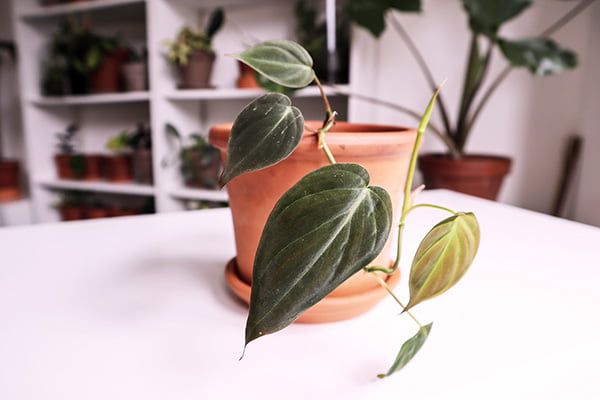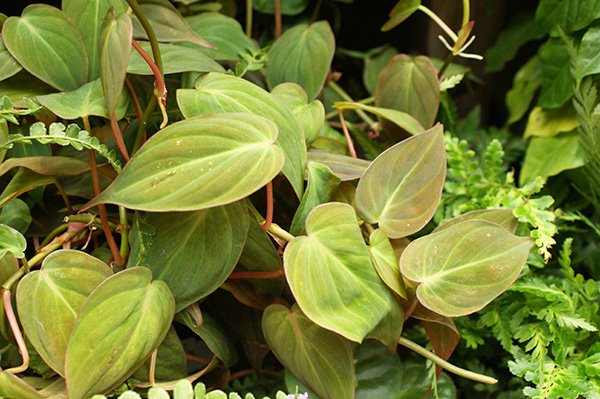Philodendron Micans - or Velvet Leaf Philodendron - is a vining plant with the most adorable leaves! Small, shifting from burgundy to green, and covered in a soft, velvet fuzz, this houseplant is a must-have! And thankfully, Philodendron Micans care is pretty straightforward.
Below, we'll take you through each aspect of Philodendron Micans care so your plant can be as healthy as possible!
Botanical Name
Common Name
Plant Type
Mature Size
Sun Requirement
Soil Type
Hardiness Zone
Pet Friendly
Philodendron hederaceum 'Micans'
Heart-Leaf Philodendron and Sweetheart Plant
Perennial
8 in. tall, 24 in. long
Bright to medium indirect light
Potting soil
10-11
No
What Is Philodendron Micans Plant?
Philodendron Micans is one of the most unique of all the philodendron plants. It is aptly nicknamed "Velvet Leaf Philodendron." On young plants, each trailing stem has a burgundy color. The leaves are small, range in color from burgundy to deep green, and have a soft, velvety texture! As the plant matures, it loses the depth of burgundy color, and the leaves lose that velvet texture.
The leaf shape and growth pattern are very similar to the heart leaf philodendron. However, Philodendron Micans don't have glossy green leaves. But instead, velvety, heart-shaped, burgundy color leaves.
Native to Central America, a well-supported Philodendron Micans will grow to a full foot in height. A moss pole is a great way to support this climbing plant! The vining plants can grow even longer if left to trail on a shelf or in a hanging basket.

Source: Flickr
Philodendron Micans Care Requirements
Light
Velvet Leaf Philodendron plants require lots of bright, indirect light. Direct sunlight on its heart-shaped leaves will scorch them, and the leaves will turn yellow. However, yellowing leaves may also be a sign of too little light. Tricky!
Place it near a south-facing window, where it will receive bright, indirect light all day. Another great option is an east-facing window. It might receive direct light in the morning, but morning sunlight is a milder natural light.
Water
Philodendrons tend to be thirsty plants, and they like evenly moist soil! Your challenge is not to overwater your Philodendron Micans while not letting the soil completely dry out.
To keep the soil moist, the first step is to make sure you use proper soil in a pot with drainage holes. Then, always check the top few inches of the soil before watering.
If you feel moist soil, wait a few days before watering. If the soil feels dry, give it a drink! You can typically plan on a weekly watering schedule during the growing season (spring and summer months) and every two weeks during the dormant season (autumn and winter).
Temperature
The Philodendron Micans grows best in temperatures between 65 and 75 degrees Fahrenheit - which is handy because most households are kept in this temperature range!
Keep mindful of areas in your home where it might be colder or hotter, however. Avoid placing it near radiators, heating and cooling vents, drafty windows, and fireplaces.
Humidity
Philodendron Micans like a humid environment, and the ideal air moisture range is between 60% and 80%. Without ample humidity, the leaves of this trailing plant will turn brown and crispy around the edges. If your house is not typically kept that humid, there are ways to boost the air moisture in the space directly around your plant.
Grouping
Place your philodendron by other plants. Plants naturally increase the humidity in the air directly around them.
Use a pebble tray filled with water
Fill a tray with pebbles, then fill it with water to just under the top of the pebbles. Place your pot on the pebbles. Water will evaporate from the tray into the air around your plant.
Use a humidifier
Add a humidifier to your space when humidity is low. Particularly in dry climates, you might benefit from a moisture boost as well!
Place In Bathroom
Place your plant in the bathroom. The steam from showers and baths will help your Philodendron Birkin thrive.
Soil
You can purchase bags of potting mix specially formulated for aroid plants, but you can easily mix up your own! Start with standard potting soil with lots of nutrients and a neutral pH. Then, add perlite or orchid bark for drainage and filtration and sphagnum peat moss for moisture retention. It's also helpful to add various organic matter to your soil, such as compost or worm castings!
Fertilization
Philodendron Micans benefit from monthly fertilizing. Use a balanced, water-soluble fertilizer that contains both calcium and magnesium. Fertilize your plant every month during the growing season and every other month during the dormant season.

Source: Flickr
Pruning
While not strictly necessary, your Philodendron Micans will have a fuller appearance if you prune them regularly. Every time you clip a trailing vine, it will produce new growth on the side of the stem right above the cut.
Repotting
When repotting your Philodendron Micans, ensure that the pot size isn't too much larger than the root ball. Instead of packing the root ball with potting soil, it's recommended to go with a coarser tropical mix to provide plenty of air pockets.
Philodendron Micans Propagation
The optimal time to propagate Philodendron Micans is in spring and summer. Propagating Philodendron Micans is best done through stem cuttings. Many plant enthusiasts like using a clear container as it allows you to monitor root development and monitor the soil's moisture level.
To propagate a Philodendron Micans through stem cutting, use clean shears to cut a 2 to 4-inch length of vine. Cut 1/4 inch below an aerial node or aerial roots, and ensure that the cutting has at least a few leaves at the other end!
Remove the leaves near the base of the cutting, and place them in a glass of water, ensuring that the node is completely submerged. Then, place them in a bright, sunny spot. Change out the water periodically. You should notice the roots in about a month. When the roots grow to 2 inches long, you can transplant them in a pot with well-draining soil.
Common Problems
Philodendron Micans will sometimes have the same problems common to most houseplants.
Root Rot
Like many plants, Philodendron Micans may develop root rot if left in wet soil for too long. You'll need to unpot the plant, remove dead roots, let the remaining roots dry out, then repot in dry soil.
Common Pests
Philodendron Micans may sometimes become infested with spider mites, mealybugs, scale, and thrips. Infestations by common houseplant pests are typically treated by pruning away leaves with the heaviest concentration of pests, then washing the remaining leaves with insecticidal soap, neem oil, or rubbing alcohol.
Falling Leaves
If your Philodendron Micans leaves are falling off, it could be due to draft, insufficient light, or low humidity. Move your plant to a different location and avoid these conditions.
Brown edges or tips
Browning can indicate that the plant is too dry or getting too much direct sun. Too much light can burn the leaves and cause them to look brown. Using too much fertilizer can also have burning effects on the leaves.
Is The Philodendron Micans Toxic To Animals?
Philodendron Micans plants are toxic to humans and pets due to calcium oxalate crystals. If the leaves or stems are ingested, symptoms such as burning and swelling lips and tongue, vomiting, and diarrhea can occur.
Is Philodendron Micans Rare?
Philodendron Micans used to be rare, but it has become easier to find in recent years. You should be able to find Philodendron Micans plants at your local nursery, hardware store, and online plant stores.
